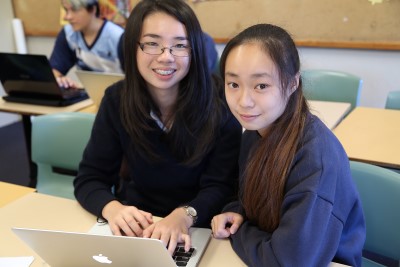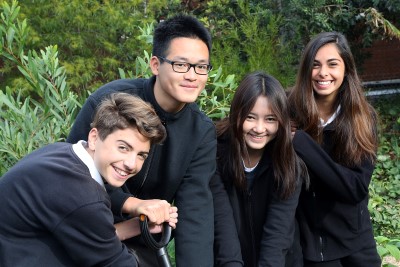Introduction

The skills you learned and experiences you had before and during your journey to Australia are important parts of who you are. Your inner strength and resilience have been very important in helping you make this journey. In this session you will learn about strategies to support your emotional health.
By the end of this session you should:
-
have had an opportunity to share stories of your journey to Australia
-
reflect on the skills and strengths you have gained
-
become more aware of your own resilience and how this can assist you now and in the future.
Preparation and resources

To complete this session, you will need access to the following resources:
-
a computer
-
documents (found in the Activities section below)
-
7.1 – Skills and hopes
-
7.2 – Belonging
-
7.3 – Dealing with stress.
-
Activities

Suggested activities for this session:
Take some time to think about a place that you feel positive about and that makes you feel happy. It could be a place in Australia or overseas. Open Google Earth on your computer and find that place in the world.
Each student will have an opportunity to show their chosen place on Google Earth and tell the rest of the class about the place. Remember to zoom out to show the other students where in the world your location is and zoom in to see more details. Tell the rest of the group about why this is a special place and why it makes you happy.
You will work on this activity individually. This is an opportunity for self-reflection and you will not be asked to share your work with the group.
Open a copy of 7.1 – Skills and hopes1 and think about 2 skills that you had before your journey to Australia. Record these in the first 2 circles. Now think of 2 skills that you have learnt since arriving in Australia and record these in the next 2 circles.
Finally, think of 2 hopes that you have for your future and record these in the 2 clouds at the bottom of the diagram.
Activity 3 – Strengths and resilience
There may be things in your past that have caused pain and hurt. Although you may not always feel it, you have the strengths and resources to recover and move forward.
To enable and support this recovery it is important that you have a sense of belonging, have social connections and support, and be involved with your school or community.
When we are part of a family, a school or a cultural/social/sports/religious group we have a sense of belonging. When we talk to other people, make friends and have different people we can go to if we need help, then we have good social connections and support.
You can get involved in your school or community by joining a school sport team or special interest group, trying new activities at school, helping with the Peer Support program or volunteering to help in the school canteen or library. Being involved in the community can also mean taking part in special language or cultural events, joining in with local activities or helping elderly and disabled people.
Open a copy of 7.2 – Belonging2 and work through the activity. Remember that a great way to feel happier at high school is to make friends, join in with activities and get help from your teachers and other students.
Activity 4 – Dealing with stress
Moving to a new country and starting a new school can be stressful and it is important to learn ways of dealing with this stress. Open a copy of 7.3 – Dealing with stress3 and then, as a group, discuss the information in the page.
Think about ways that you deal with stress and complete the bottom section of the worksheet. If the group discussion gave you some new ideas, be sure to record those also.
Conclusion

If there is time, you could share the hopes that you have for your future in Australia with the rest of the class.
Take some time to reflect on your strengths and skills. Make a promise to yourself to try to deal with high school in a positive way.
Remember to make a note of different people that you can talk to if you need any help in high school. If you have any questions, ask your teacher now.
This is the last of the weekly sessions for The Welcome Program. There will be a final follow-up session later in the year. Make a note in your diary about the time and date for the follow-up session.
Remember to thank your teachers and other students that you worked with during the session.
Teaching notes
The Welcome Program sessions are designed to be teacher facilitated. Students should not be left to complete the activities without guidance.
This session provides students with an opportunity to reflect on the experiences and the skills they acquired before arriving in Australia as well as the resilience and strengths they possess.
Students will develop an understanding of the processes of recovery and resettlement. The focus is on the resilience the students have within, not on simply sharing the difficulties of their journey (although it is important that these be acknowledged). They will also learn about strategies to support their own emotional wellbeing.
It is recommended that the School Counsellor co-present this session.
Aims
-
Students will have an opportunity to share stories of their journeys to Australia.
-
Students will reflect on the skills and strengths they have gained.
-
Students will become more aware of their own resilience and how this can assist them now and in the future.
-
Teachers and school counsellors will learn more about their students.
Before conducting this session, read all of the information in this resource and plan accordingly. You may choose to conduct some activities without using student computers and will therefore need to print out copies of worksheets for the students.
Invite the School Counsellor and/or Head Teacher Welfare to co-present this session.
Students will need access to the following resources:
-
computers
-
their NSW DoE student account to access Google Drive (test to see if students are able to log on to school computers and access the internet)
-
if students are unable to access Google Drive, you may need to print copies of all the worksheets.
-
Explain to students that this session will look at their journeys to Australia and the strengths and skills they have developed.
Ask the students to think about a place that is important to them and makes them feel happy. It could be a place in Australia or overseas. Each student then opens Google Earth on a computer and finds that place in the world.
Invite the students one at a time to show their chosen place to the rest of the class, describe why it is so important and explain the happy memory that they have about the place. Encourage the students to zoom out to show the class where in the world the place is and zoom in to show more details.
You could extend this activity by using Google My Maps instead of Google Earth and asking the students to nominate key locations on their journey to Australia. Ask the students to identify 2 or 3 skills they have learnt during their journey. (For example, learning to speak another language, helping in a shop, helping with the cooking or looking after younger children.) These key locations and skills can be recorded on their Map and then presented to the class or a small group. Information on using Google My Maps can be found on the My Maps Help Centre website4.
Ask students to open a copy of 7.1 – Skills and hopes1 and think of 2 skills they learnt before they came to Australia. These should be recorded in the first 2 circles.
Then ask students to think of 2 more skills that they have learnt since arriving in Australia and record these in the next 2 circles.
Finally, ask students to write down 2 hopes that they have for their future in Australia. This is an opportunity for personal reflection and does not need to be shared with the group.
Activity 3 – Strengths and resilience
Discuss with students that although there may be things in their past that have caused pain and hurt, they have inside them the strengths and resources to recover and move forward.
Explain to students that the 3 most important things to enable this recovery are having a sense of belonging, having social connections and support, and being involved with their school or community.
Explain that when we are part of a family, a school or a cultural/social/sports/religious group we have a sense of belonging. When we talk to other people, make friends and have different people we can go to when we need help, then we have good social connections and support.
Students can be involved in their school or community by joining a school sport team or special interest group, participating in school activities, helping with the Peer Support program or volunteering to help in the school canteen or library.
Being involved in the community could also mean taking part in special language or cultural events, joining in with local activities or helping elderly and disabled people.
Ask the group to open a copy of 7.2 – Belonging2 and work through the activity. Emphasise to the students that they will probably feel happier at high school if they make friends, join in activities and get help from their teachers and other students.
Activity 4 – Dealing with stress
The worksheet 7.3 – Dealing with stress3 explains how stress can affect our lives and suggests ways that students can help themselves. Read through and discuss the content of the worksheet with the class and then have the students complete the questions individually.
Facilitating teachers should be aware that students may feel safe enough to disclose sensitive information about past traumatic experiences in this session. Please read the following information on dealing with disclosures.
To conclude, ask if there are any students who would like to share their hopes for their future in Australia.
Emphasise to students that each of them has the strengths and skills to deal with high school in a positive way.
Thank students for their participation in the program. Explain that although this is the end of the weekly sessions, students can always ask for more information and help about specific issues. Check that students know who to go to if they need help.
Explain that there will be a follow-up session early in the next school term, at which they will receive their certificates.
For more information, visit the NSW Department of Education’s The Welcome Program website5.
Links
- https://docs.google.com/presentation/d/1MM80YAKNn0qQlbIE1O_SssIaKxJx03xUM58-jQ8lagc/copy
- https://docs.google.com/presentation/d/19EAk5v6qPQBkf0cfuudFAfUDFj-eTHd94zj_Ji7nOTI/copy
- https://docs.google.com/document/d/18cKG0TDm6lQSV9HUmxfwHgvwxOVnrmotTZ_KxPH-GlI/copy
- https://support.google.com/mymaps/#topic=
- https://education.nsw.gov.au/teaching-and-learning/curriculum/multicultural-education/refugee-students-in-schools/whole-school-response/the-welcome-program